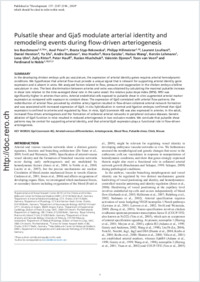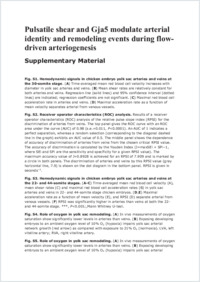Pulsatile shear and Gja5 modulate arterial identity and remodeling events during flow-driven arteriogenesis
- Buschmann, Ivo Experimental and Clinical Research Center (ECRC) of the Charite and the Max-Delbrueck Center for Molecular Medicine (MDC), Berlin-Buch, Germany - Department of Internal Medicine/Cardiology, CCR, Charite, Berlin, Germany - Center for Stroke Research Berlin (CSB), Charite, Berlin, Germany
- Pries, Axel Department of Physiology, CCR and German Heart Center, Charite, Berlin, Germany
- Styp-Rekowska, Beata Department of Physiology, CCR and German Heart Center, Charite, Berlin, Germany
- Hillmeister, Philipp Experimental and Clinical Research Center (ECRC) of the Charite and the Max-Delbrueck Center for Molecular Medicine (MDC), Berlin-Buch, Germany - Center for Stroke Research Berlin (CSB), Charite, Berlin, Germany
- Loufrani, Laurent Department of Neurovascular Biology, University of Angers, France
- Henrion, Daniel Department of Neurovascular Biology, University of Angers, France
- Shi, Yu Experimental and Clinical Research Center (ECRC) of the Charite and the Max-Delbrueck Center for Molecular Medicine (MDC), Berlin-Buch, Germany
- Duelsner, Andre Experimental and Clinical Research Center (ECRC) of the Charite and the Max-Delbrueck Center for Molecular Medicine (MDC), Berlin-Buch, Germany
- Hoefer, Imo Department of Experimental Cardiology, Division of Heart & Lungs, Utrecht, The Netherlands
- Gatzke, Nora Experimental and Clinical Research Center (ECRC) of the Charite and the Max-Delbrueck Center for Molecular Medicine (MDC), Berlin-Buch, Germany
- Wang, Haitao Experimental and Clinical Research Center (ECRC) of the Charite and the Max-Delbrueck Center for Molecular Medicine (MDC), Berlin-Buch, Germany
- Lehmann, Kerstin Experimental and Clinical Research Center (ECRC) of the Charite and the Max-Delbrueck Center for Molecular Medicine (MDC), Berlin-Buch, Germany
- Ulm, Lena Department of Physiology, CCR and German Heart Center, Charite, Berlin, Germany
- Ritter, Zully Department of Radiology, CBF, Charite, Berlin, Germany
- Hauff, Peter Bayer Schering Pharma AG, MicroCT Unit, Berlin, Germany
- Hlushchuk, Ruslan Department of Gross Anatomy and Vascular Biology, University of Fribourg, Switzerland
- Djonov, Valentin Department of Gross Anatomy and Vascular Biology, University of Fribourg, Switzerland
- Veen, Toon van Department of Medical Physiology, Division of Heart & Lungs, Utrecht, The Netherlands
- Le Noble, Ferdinand Experimental and Clinical Research Center (ECRC) of the Charite and the Max-Delbrueck Center for Molecular Medicine (MDC), Berlin-Buch, Germany - Center for Stroke Research Berlin (CSB), Charite, Berlin, Germany - Max-Delbrueck Center for Molecular Medicine (MDC), Department of Angiogenesis and Cardiovascular Pathology, Berlin, Germany
-
2010
Published in:
- Development. - 2010, vol. 137, p. 2187-2196
Gja5 (connexin 40)
Arterial-venous differentiation
Arteriogenesis
Blood flow
Pulsatile shear
Chick
Mouse
English
In the developing chicken embryo yolk sac vasculature, the expression of arterial identity genes requires arterial hemodynamic conditions. We hypothesize that arterial flow must provide a unique signal that is relevant for supporting arterial identity gene expression and is absent in veins. We analyzed factors related to flow, pressure and oxygenation in the chicken embryo vitelline vasculature in vivo. The best discrimination between arteries and veins was obtained by calculating the maximal pulsatile increase in shear rate relative to the time-averaged shear rate in the same vessel: the relative pulse slope index (RPSI). RPSI was significantly higher in arteries than veins. Arterial endothelial cells exposed to pulsatile shear in vitro augmented arterial marker expression as compared with exposure to constant shear. The expression of Gja5 correlated with arterial flow patterns: the redistribution of arterial flow provoked by vitelline artery ligation resulted in flow-driven collateral arterial network formation and was associated with increased expression of Gja5. In situ hybridization in normal and ligation embryos confirmed that Gja5 expression is confined to arteries and regulated by flow. In mice, Gja5 (connexin 40) was also expressed in arteries. In the adult, increased flow drives arteriogenesis and the formation of collateral arterial networks in peripheral occlusive diseases. Genetic ablation of Gja5 function in mice resulted in reduced arteriogenesis in two occlusion models. We conclude that pulsatile shear patterns may be central for supporting arterial identity, and that arterial Gja5 expression plays a functional role in flow-driven arteriogenesis.
- Faculty
- Faculté des sciences et de médecine
- Department
- Département de Médecine
- Language
-
- English
- Classification
- Biological sciences
- License
-
License undefined
- Identifiers
-
- RERO DOC 20379
- DOI 10.1242/dev.045351
- Persistent URL
- https://folia.unifr.ch/unifr/documents/301757
Other files
Statistics
Document views: 103
File downloads:
- pdf: 323
- Supplementary material: 173

